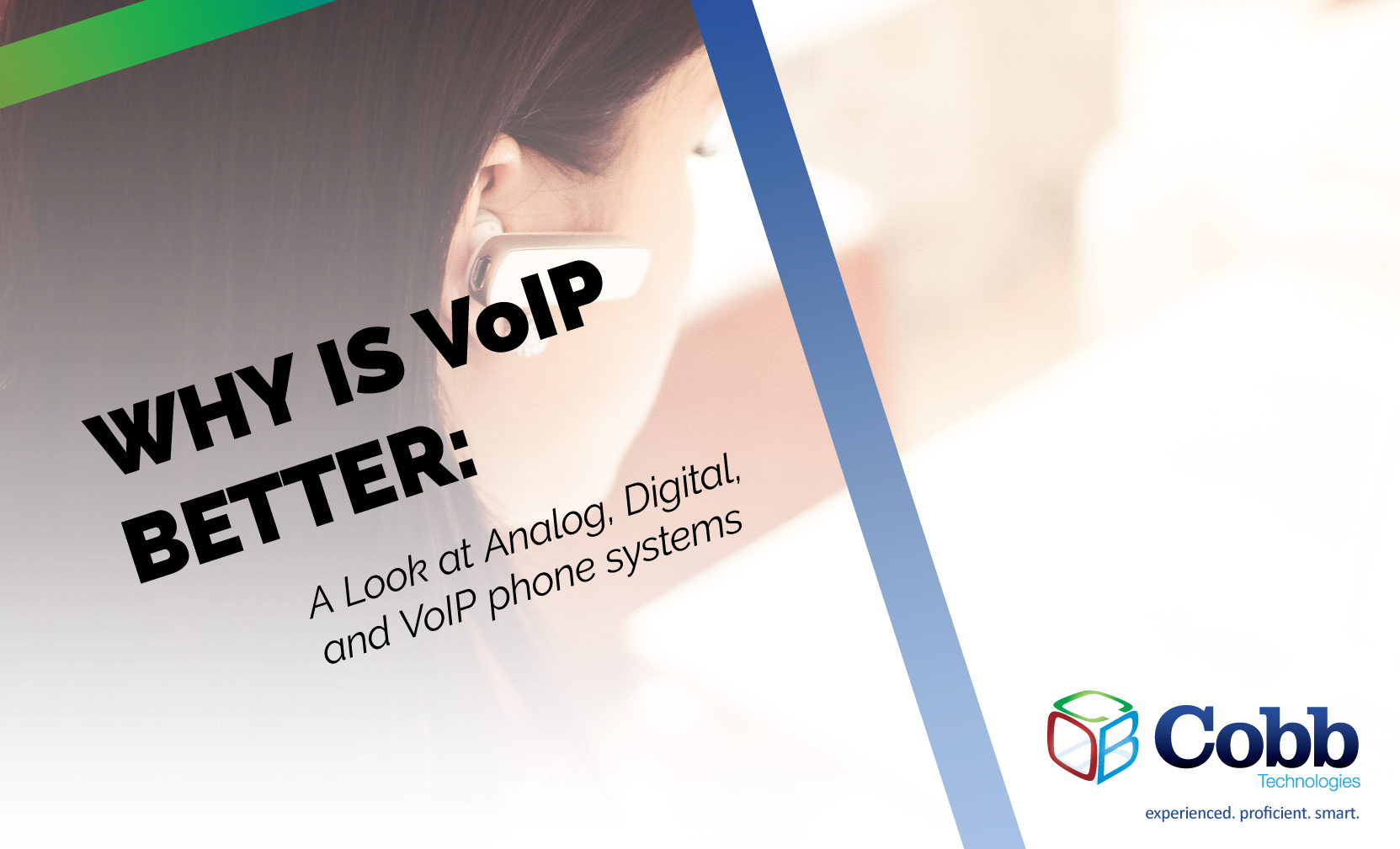3 min read
Building Culture That Works: Cobb Tech Named One of VA's Best
Cobb Technologies has been honored as one of the 2025 Best Places to Work in Virginia by Virginia Business and Best Companies Group. This prestigious...

A phone is a phone, right? There may be more going on behind the scenes of your office’s phone system than you’d expect, however. And, even more important — there may be data and functionality your business is losing to the void of analog and digital phone systems.
It’s no spoiler — VoIP (Voice over Internet Protocol) phone systems are better for business when compared to analog and digital counterparts. But before we get into why, let’s quickly go over how these three phone systems work.
Analog phone systems are akin to an antique car — due to their age, they are very rarely found in a business. Analog phone systems come with the basic functionality of any phone — outbound calling, inbound calling, voicemail, transferring, and hold.
Analog phone systems are very robust, and will work regardless of access to power — an analog phone only needs a phone line to operate.
Digital phone systems provide the same functionality as an analog phone system, in addition to caller ID. Other than this feature, there is very little a digital phone system provides that an analog system does not.
Digital phone lines convert analog signals (electrical signals traveling through copper wires) into binary data. This binary signal is transported over the phone line, and then decoded on the receiving end.
VoIP phone systems eschew the need of a phone line completely. VoIP systems rely entirely on an internet connection to send voice data from one end of a phone call to the other. VoIP phones can communicate with analog and digital phone systems, and can also be supplemented with mobile devices via call-forwarding.
The benefits of VoIP boil down to three main points: VoIP gives you the ability to control, set, and manage phone conversations throughout your organization, as well as the ability to measure and analyze data created by those conversations, and possibly the most important benefit in this blog — cost.
VoIP systems work within any business’ framework. No matter how decentralized your workforce is, every employee — no matter how remote — can access their phone line via their mobile device. Even more importantly, VoIP systems allow for call-forwarding to mobile devices, regardless of the provider of the smartphone.
By setting a call-flow that forwards incoming calls to your employees cellphones, you also negate the chance of missing a call due to downed internet service. Despite VoIP’s reliance on an internet connection, VoIP systems can still work without an internet connection, provided you have set up a backup call-flow previously. To learn more about this, watch What Happens To My VoIP Service If My Internet Is Down?
VoIP phone systems are highly adaptive to any organization’s structure — and as mentioned above, VoIP systems give you the ability to customize every aspect of your call-flows and rules, if your VoIP provider offers a robust platform.
Here are some of the most commonly used features of VoIP systems:
You may notice that the features listed above are what you would expect from a dedicated call center. With a VoIP system, you can make use of features that before were only available to organizations willing to spend tens or hundreds of thousands of dollars on robust phone systems.
With a historic lack of features like the ones listed above, it can often be difficult to imagine how your organization would benefit from call monitoring, or measuring call performance. But, consider this for a moment — most likely, your website is set up to track and measure who is visiting your organization’s website, and how they engage with the content on it.
Why shouldn’t your phone conversations benefit from the same data collection? Think about the difference in the quality of conversation between an email and an in-person meeting. By not measuring call performance and other metrics, you’re missing out on a huge chunk of valuable customer data.
The most common issue users experience when using a VoIP phone system is sound distortion. This distortion can create a wide variety of sounds and pitches, and will modulate voices to sound as if they are speaking in a tunnel, or underwater. Even more distressing are jumbled or stuttered words.
While these sounds may be numerous, their cause is the same: a lack of bandwidth. A VoIP system (as the name Voice over IP suggests) is reliant on an internet connection. If this connection is slow, voice data is lost during transfer, or incoming data is missed as data packets clog your business’ network.
Luckily, this issue comes with a straightforward fix — a Session Border Controller. You can think of a SBC like an old-school telephone operator; sitting at a switchboard, manually routing and transferring phone lines and calls, all while making sure to not overload the system. A SBC is, of course, not a person, but a device — and it does what that old operator does, but at a much more efficient rate.
SBCs govern and manage a specific portion of your network’s bandwidth, ensuring there is always enough bandwidth to properly support your phone lines. Like all components of a VoIP system, a SBC’s rules can be customized to fit your organizations needs — meaning if you run a call-heavy team, your SBC can account for that. Conversely, if you need to reroute all of your bandwidth to a specific portion of your network, your SBC can temporarily relinquish bandwidth depending on your need.
Another common issue users experience with VoIP phones is the “two cords” problem. Workers already have enough to clutter their workspace, and a phone that needs two cords is a hassle. But, just like the bandwidth problem, there’s an acronym here to save the day - PoE. Power over Ethernet cords do exactly as their name describes; run power through an ethernet cable.
Note: PoE cables may require upgrades to your office’s wiring. If this is an expense you business isn’t ready to take on, VoIP phones can use a dedicated power cord to negate the need to upgrade.
VoIP systems face one last problem: the provider. Like any product, a VoIP platform is only as good as the business that made it. There are quite a few VoIP platforms on the market today — but they do tend to follow a simple rule; the cheaper they are, the less customization they provide.
Many businesses become disillusioned when confronted with a bad VoIP experience due to a cookie-cutter VoIP platform. Often, quick-and-easy VoIP solutions ignore the unique needs every business has, and will negate to install a robust platform manager, as well as a SBC. To learn more about what a good VoIP installation looks like, watch our video, What’s the VoIP Deployment Process Look Like?
VoIP systems have the capability of integrating in a highly-customized environment, and can integrate directly with software like Microsoft Office 365, Salesforce, and a plethora of case management platforms. With out-of-the-box solutions, however, integrations are often lacking. To learn more, read What’s The Best VoIP Platform?
Many MITS providers offer customizable VoIP packages. If you want to make sure your VoIP system is properly installed and integrated with your organization’s environment, find a MITS provider who is experienced with VoIP solutions.
To learn more about what to expect from speaking to a MITS provider about VoIP setup, watch The 4 Steps a Good VoIP Provider Should Take You Through as a Potential Client.

If you’re speaking to a potential VoIP provider, make sure to ask them our 14 questions. To get access to our VoIP Litmus Test, fill out the form below:

3 min read
Cobb Technologies has been honored as one of the 2025 Best Places to Work in Virginia by Virginia Business and Best Companies Group. This prestigious...

5 min read
Cobb Technologies is honored to hold the SWaM (Small, Women-owned, and Minority-owned Business) certification, awarded by the Commonwealth of...

5 min read
Every year, thousands of Veterans transition from military service to civilian careers in Virginia, bringing invaluable skills and experiences to...